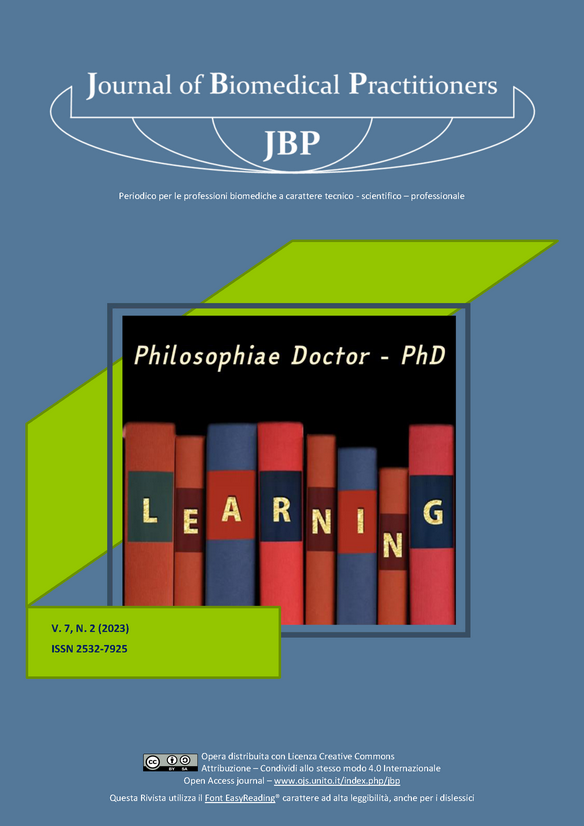Aggressione sul posto di lavoro verso gli operatori sanitari: costruzione e sperimentazione di uno strumento di valutazione del rischio.
Contenuto principale dell'articolo
Abstract
Obiettivo
La frequenza di segnalazione di atti violenti in ambito sanitario rappresenta il principale parametro per la Valutazione del Rischio (VdR) di subire aggressioni fisiche e/o verbali a danno degli operatori sanitari. Questo studio ha voluto indagare il fenomeno delle aggressioni in sanità, identificando una metodologia di valutazione multidimensionale per stimare e classificare il rischio anche in assenza di segnalazioni spontanee, operando quindi in fase di prevenzione.
Materiali e metodi
Inizialmente è stata condotta una revisione della letteratura già esistente per identificare i Fattori di Rischio (FdR) e le Misure di Prevenzione e Protezione (MPP); successivamente sono stati analizzati tali dati che hanno portato all’elaborazione di un algoritmo. Quest’ultimo è stato poi somministrato durante le VdR ad un totale di 32 unità operative appartenenti all’Azienda ULSS 4 "Veneto Orientale".
Risultati
l’attuazione di MPP ha abbassato il rischio espositivo iniziale in 22 delle 32 sedi valutate (68,7%). Le strutture a maggior rischio risultano essere quelle che applicano minori MPP in presenza di elevati FdR. Pronto Soccorso (PS), Servizio per le Dipendenze (SerD) e reparti di Medicina, considerati a maggior rischio dalla letteratura [5] [6] [15] [16], sono invece le unità operative che meglio conoscono il fenomeno e adottano di conseguenza maggiori MPP per contenerlo. La dimensione “paziente” è quella che pesa di più sulla determinazione dell’indice di rischio IR (35%).
Discussione
L’utilizzo di un algoritmo che mette in relazione FdR e MPP permette di identificare la composizione del rischio aggressioni in termini quantitativi e qualitativi. In questo modo la VdR risulta più completa, in quanto le sedi non sono valutate solamente attraverso i FdR [13] [14], ma anche pesando le MPP attuate per fronteggiare il fenomeno. Questo costituisce una novità nel campo della prevenzione.
Conclusioni
L'approccio utilizzato ha permesso di affermare che il rischio di aggressioni è multidimensionale ed è generato dalla complessa interazione di più fattori raggruppati nelle diverse dimensioni. Conoscere il rischio aiuta a prevenirlo e l’attuazione di idonee MPP, pur in presenza di elevati FdR, ne abbassa le potenzialità di danno.
Downloads
Dettagli dell'articolo
Gli autori mantengono i diritti sulla loro opera e cedono alla rivista il diritto di prima pubblicazione dell'opera, contemporaneamente licenziata sotto una Licenza Creative Commons - Attribuzione che permette ad altri di condividere l'opera indicando la paternità intellettuale e la prima pubblicazione su questa rivista.
Riferimenti bibliografici
[2] Veronico L, Brusco A, Bucciarelli A, Mignacca FM, Frusteri L. Andamento degli infortuni sul lavoro e delle malat-tie professionali. Roma: INAIL; 2020. 12 p. Report No.: 10;
[3] Rossi P, Mele A, Punziano A. Gli episodi di violenza nei confronti degli esercenti le professioni sanitarie Inail. I fact sheet della sovrintendenza sanitaria. Roma: Sovrintendenza sanitaria centrale. Inail; 2020. 7 p.;
[4] Regione Veneto. Aggressione e violenza contro il personale sanitario: dalla regione un documento di indirizzo e un corso per formare 90 istruttori “antiviolenza”. Venezia: Regione Veneto; 10 marzo 2022. https://www.regione.veneto.it/web/guest/article-detail?articleId=13542489 [consultato il 18 luglio 2022];
[5] Cgil Funzione Pubblica. Stop alle aggressioni al personale sanitario. 2022. 16 p.;
[6] Ministero della Salute. Raccomandazione per prevenire gli atti di violenza a danno degli operatori sanitari. Ro-ma: Ministero della Salute; 2007. 15 p.;
[7] Mamo C, Pensasso M, Quarta D. Infortuni lavorativi da aggressioni nel personale sanitario: dimensioni e trend del problema. Boll Epidemiol Naz [Internet]. 2020; 1(2): 15-21. DOI: https://doi.org/10.53225/BEN_003.
[8] Phillips JP. Workplace Violence against Health Care Workers in the United States. N Engl J Med [Internet]. 2016; 374, 1661-1669. DOI: 10.1056/NEJMra1501998;
[9] Magni M, Picozzi M. Aggressività in azienda. Come prevenirla e gestirla. Egea; 2016. 88 p.;
[10] Ordine Assistenti Sociali. Indicazioni e strumenti per prevenire e affrontare il rischio di violenza nei confronti dei professionisti dell’aiuto. Roma: CNOAS; 2015. 45p.
[11] Testo unico sulla salute e sicurezza sul lavoro 2008, art.2 rev. aprile 2022. [citato il 2023 mar 14];
[12] Oud N. The perception of Prevalence of Aggression Scale (POPAS) Questionnaire. Amsterdam: Connecting; 2000. 9p.;
[13] Gentile L. Valutazione del rischio aggressione. Cuneo: SSP Asl 15; 2004. 8 p.;
[14] Direzione generale cura della persona, salute e welfare. Linee di indirizzo per la prevenzione degli atti di violen-za a danno degli operatori dei servizi sanitari e sociosanitari. Regione Emilia- Romagna: Servizio Sanitario Re-gione Emilia-Romagna; 2018. 27 p.;
[15] Direzione programmazione sanitaria. Aggressioni e atti di violenza a danno degli operatori sanitari. Prevenzione e gestione degli eventi. Linee di indirizzo per gli operatori del servizio sanitario della regione del Veneto. Vene-zia: Azienda Zero; 2022. 34 p.;
[16] UOS Rischio clinico e sicurezza del paziente, UOC SPDC, UOS SPP. Aggressioni e atti di violenza a danno degli operatori sanitari. Prevenzione e gestione degli eventi (rev.4). San Donà di Piave (VE): ULSS4 Veneto Orientale; 2022. 25 p.;
[17] Direzione generale della programmazione sanitaria. Linee di indirizzo nazionali sul triage intraospedaliero. Ro-ma: Ministero della Salute; 2019. 39 p.;

